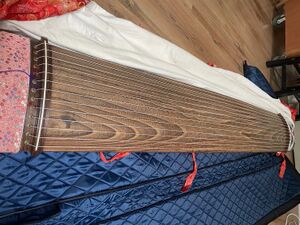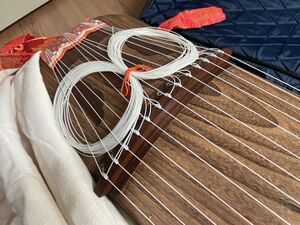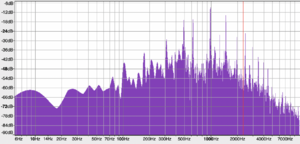PHYS341/2024/Project4
Koto (instrument)
The Koto is a traditional Japanese instrument that is still played today. It is a 13-stringed zither that is plucked to produce sound. Although many Koto songs are old and traditional, there are still modern Koto pieces being composed today as well as Koto covers of modern songs.

History of the Koto
In the Nara period (710-794), Chinese musicians brought the Koto to Japan as an instrument of the gagaku, or the court music ensemble. However, the Koto was more commonly used outside of this court music by the 17th century. Furthermore, until the 20th century, most Koto music was vocal with a single Koto accompaniment. Although Yatsuhashi Kengyo was named the father of modern Koto music, most students were young middle- and upper-class women as learning Koto was a sought after skill, a display of good character, especially as a prospective wife.
Physical Description, Structure, and Construction
The Koto has a length of about 6 feet long, it is 10 inches wide, and 2 inches thick. It is made up of two pieces, one is a hollowed-out top piece and the second is a flat bottom piece. This makes it a half-tube instrument.

The end of the Koto that is played is slightly raised, about 4-5 inches high, and is elevated using a short stand or two short feet. On the side of the instrument that is played, there is a hole on the underside. There is another hole for the strings to pass through on the opposite end. The main part of the Koto is made from the paulownia tree. The strings, which are plucked to produce sound, are strung very tightly. While traditionally and originally, the strings were made from silk, most players now use synthetic strings due to the delicate and fragile nature of silk strings, especially because they are so taut. However, silk strings are still used by professionals, or performers wishing to have a different timbre. Under each string is a moveable bridge (not shown in the images), which are used to tune the Koto to one of the pentatonic tunings. The bridges were originally made from ivory or wood tipped with ivory, however, now most players tend to use plastic bridges. Professional players will still use ivory bridges during their performances. On the top piece of the Koto are designs or patterns which are carved into the wood. This changes and improves the tonal quality of the instrument. These designs are made from scorching the surface with a hot iron. Furthermore, the natural wood grain pattern of the Koto is used to determine the quality of sound that the Koto will have.

How it is played
The player of the Koto sits on the floor in a seiza position, which is a traditional Japanese kneeling position. Or, the player may sit in chairs, with the Koto resting on a stand. The strings are plucked with plectra or picks on the thumb and first two fingers of the right hand. The plectra are made of ivory or plastic and are attached to the fingers with leather or paper bands. Of the plectra, there are two types: Ikuta-ryu, which are square, and Yamada-ryu, which are rounded or fingernail shaped. These names are derived from two Koto masters, who developed their own styles of playing. To change the pitch of the string, this is done by pressing the string down with the left hand on the left side of the bridge.

Acoustics of the Koto
Although the acoustic properties of the Koto have not been researched widely, through modern technology and tools that are used in acoustic research, it is now possible to more
deeply understand the acoustic properties and resonances of the Koto instrument. This is mostly due to a few things: there being a focus on research for European instruments; the Koto being grouped with other wooden instruments; a focus on Chinese instruments; the study of Japanese lutes. These have hindered the progress of extensive research for the instrument. The grain pattern and physical properties of Paulownia wood are also not expansive and is an important component to consider when researching and understanding the acoustic properties of the Koto. One of these modern technologies used to study the Koto is through Finite Element (FE) studies. These FE studies can also be used to expand knowledge of the physical properties of the materials that are used in making Kotos. They also have the ability to predict and visualize the vibrational behaviour of a musical instrument and create associated sound files. Other technologies that are used are X-rays and X-ray CT scans. They are used to research a musical instrument's characterization, preservation, restoration, and re-creation. The materials that are used, specifically the Paulownia wood, is important for acoustic analysis. Paulownia wood has a density of 50–280 kg/m3. However, there is a lack of research done on the physical properties of the wood.Through analysis of the Koto by use of modelling and verification from the acoustic camera, there were consistently two peak frequencies of around 99 Hz and 84 Hz as air cavity resonance and others. In figure 4 is a comparison between the Fourier Transform of a recording of the Koto and the CT model results when played at 220 Hz.
Although such difficulties and lack of information on the physical analysis of the Koto and its sound makes it difficult to have a thorough and deep analysis of the instrument, there are still some notable aspects that can be studied.
Spectrum Analysis

Figure 5 shows the spectrum of a B4 note, which was extracted from the Koto performance recording provided on this page. The fundamental frequency as analyzed through audacity is 488 Hz. The second harmonic, which is the highest peak in the spectrum is at 995 Hz. A key aspect to note when looking at the spectrum are the other peaks that can be seen and are not multiples of the fundamental frequency. This leads to some interesting observations. One reason for these other peaks that do not appear to be the harmonics of the fundamental frequency can be due to the unique resonances produced by the Koto. Furthermore, previous research has indicated that the Koto is known for its complex resonances. Furthermore, the measurement of the shape of Paulownia wood has lead to challenges to interpret peak frequencies. This could potentially attribute to the irregular pattern of the peaks featured in the spectrum.
References
Coaldrake, K. (2020, November). A finite element model of the Japanese koto constructed from computed tomography scans. J.
Coaldrake, K. (2019, September). Measurement and modelling of the Japanese koto: Problems and solutions.
Prescott, A. (2004, June). Koto music. FSI. https://spice.fsi.stanford.edu/docs/koto_music